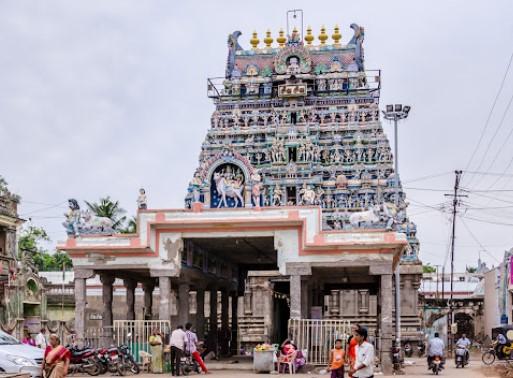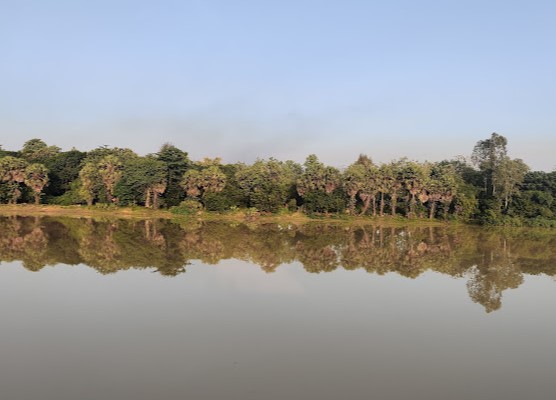This ancient temple, held in high reverence by Shaivites, was constructed during the Pallava and Medieval Chola periods. It is believed that the Saivite saint Appar embraced Saivism at this temple, making it an important site in the history of Shaivism. The temple's history is documented in several inscriptions, which trace its origins back to the reigns of various kings, including Parantaka Chola, Rajaraja Chola I, Rajendra Chola I, Kulothunga Chola I, and Vikrama Chola, as well as rulers from the Pallava and Pandya dynasties. These kings contributed to the temple's renovation and upkeep, with many performing acts of charity, such as grants and gifts.
In more recent history, the philanthropic Pudukkottai Nagarathaar family undertook major restoration work, performing the Kumbabishekam on 28th June 1917. A subsequent Kumbabishekam was held on 8th February 1973, thanks to the efforts of local devotees, ensuring the temple's continued importance and preservation.
PURANIC SIGNIFICANCE:
For the salvation of all living beings, the Lord engaged in divine play with the Goddess at Thiruvulankond, where they danced together. Despite dancing many times, the Lord faced failure. However, he declared that victory was his, and in response, the Goddess covered his divine eyes with her hands. As a result, the world was plunged into darkness, and all activities came to a halt.
Upon witnessing this, the Goddess felt sorrow for the suffering caused by her actions and sought forgiveness. The Lord instructed the Goddess to visit the Shiva temples in the world and offer worship there. He further told her that in the temple where her left eye and left shoulder trembled, she would receive his grace and victory.
Thus, after visiting many temples, the Goddess arrived at this particular temple, where her left eye and left shoulder trembled. Here, she stayed and worshiped the formless Lord, receiving blessings and attaining success. The temple is known for its Lord in Siddha form, who relieved the suffering of the people.
Karaiyearteeswarar:
The temple of Karaiyearteeswarar is associated with a significant event in the life of Saint Appar. According to legend, during the reign of the Pallava King Mahendra Varma (600-630 A.D.), the king sought to kill Appar in various ways due to his strong devotion to Lord Shiva. After multiple failed attempts, the king had Appar tied to a stone and thrown into the river. However, by the grace of Lord Shiva, the stone transformed into a boat, and Appar was safely carried to the shore near Thirupathiripuliyur. This miraculous escape pleased the Lord, who granted Appar protection from the king's wrath. In honor of this divine intervention, the place where Appar reached the shore is known as Karaiyeravittakuppam, and a festival is celebrated during the Tamil month of Chittirai to commemorate this miracle. The lord is worshiped here as Karaiyearteeswarar.
Arunthava Nayagi:
In Hindu mythology, there is a story about a game of dice between Lord Shiva and Goddess Parvathi. Although Parvathi won each time, Shiva refused to admit defeat. Parvathi, in her frustration, decided to cover Shiva's eyes, plunging the entire world into darkness. Realizing the grave mistake she had made, Parvathi prayed for forgiveness. Shiva instructed her to travel to the 1008 Shiva Sthalams and pray at each one. Upon reaching the Thirupathiripuliyur Padaleeswarar Temple, Parvathi experienced a divine vibration in her left eye and shoulder, signaling that she had completed her penance. She then prayed in the form of Arunthava Nayagi and was united with Lord Shiva.
Upamanyu's Liberation:
Upamanyu, the son of Vyagrapadarishi, once accidentally struck Devi with his foot while offering worship. As a result, Devi cursed him to become a hare. After much repentance, he was instructed to pray at the Padaleeswarar temple to break the curse. Wandering in the form of a hare for years, Upamanyu was eventually hunted by King Adirajan. While fleeing, he came into contact with the branches of the sacred Padali tree, which caused him to regain his human form.
Manganar's Transformation:
Another tale of transformation is that of Manganar, who was cursed by Sage Toomappur to become a hare for disturbing his penance. Manganar, in the form of a hare, performed penance at the Padaleeswarar temple and regained his human form, thus breaking the curse.
Lord Padaleeswarar and the River Gadilam:
Lord Padaleeswarar is also believed to have changed the course of the river Gadilam to facilitate the worship of Saint Manikkavacakar, allowing him to perform his prayers without any hindrance.
Pathiri Puliyur:
The name Pathiri Puliyur refers to the sacred place where the Pathiri tree (the temple’s divine tree) is located, and the second part, Puliyur, is linked to the tiger saint Vyagrapada, who performed penance at this site.
Vyagrapathar's Salvation:
Vyagrapathar, who witnessed the divine dance (Anandatandavam) of Lord Nataraja, is believed to have attained salvation at this sacred location, further elevating the temple's spiritual significance.
Holy Place of Great Merit:
It is said that worshiping Lord Padaleeswarar here even once is equivalent to offering prayers 16 times in Kashi, 8 times in Thiruvannamalai, and 3 times in Chidambaram, making this a highly revered and spiritually potent site.
ADMINISTRATION:
The administration of this temple is typically under the control of the local temple committee or Devasthanam. In some cases, it may fall under the management of the Hindu Religious and Charitable Endowments (HR&CE) Department of the state government, depending on the temple's location and significance.

